Yup, a bonanza of swans! And many were finally in areas where they could be seen up close. The light was often marginal but I still had a blast with them.
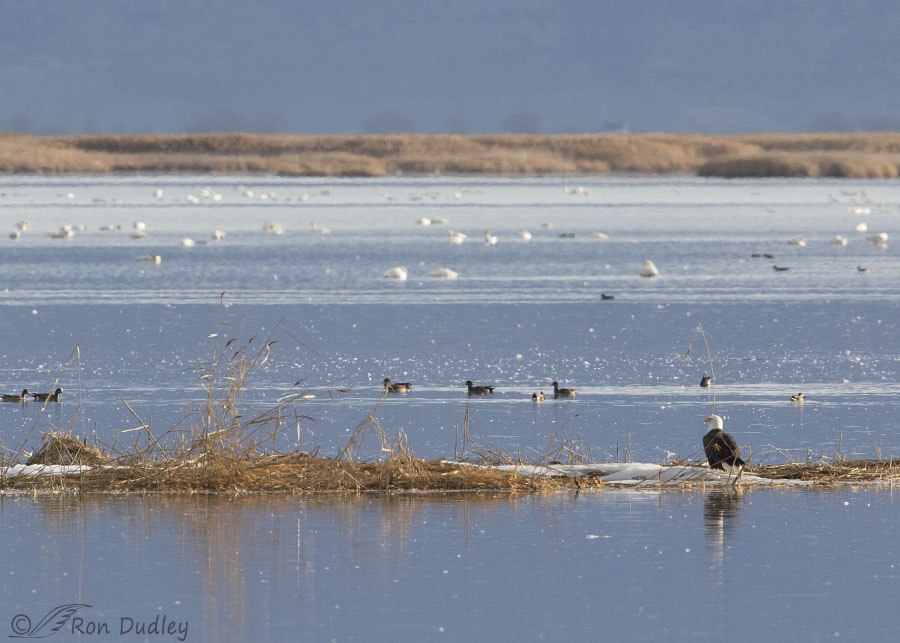
1/1000, f/10, ISO 800, Canon 7D Mark II, Canon EF 500mm f/4L IS II USM + EF 1.4 III Extender, not baited, set up or called in
This time of year many thousands of Tundra Swans are found on the refuge but they’re shy and typically so far away that all I see of them is tiny white dots on the water or ice. But yesterday the further I traveled on the auto-loop tour road the closer they were to the road. This was the scene from the west side looking east as an adult Bald Eagle surveyed its icy kingdom with many swans in the far background. The calls of swans filled the air wherever I went and that time of morning it was eerily enchanting but at first most them were so far away that even through my big lens some of them could be tricky to locate.
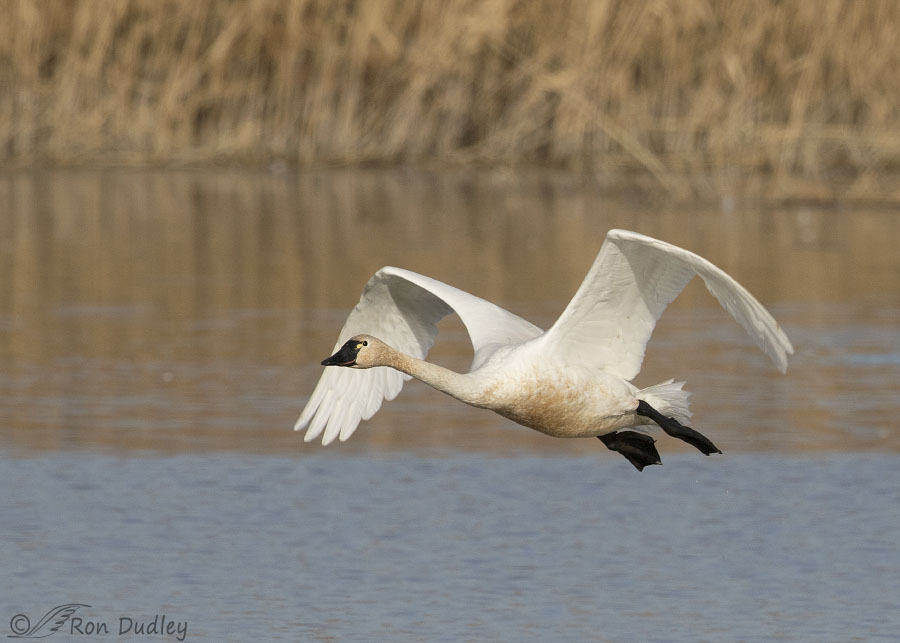
1/2500, f/9, ISO 500, Canon 7D Mark II, Canon EF 500mm f/4L IS II USM + EF 1.4 III Extender, not baited, set up or called in
But once I arrived at the south end of the loop road everything changed. There was a large group of perhaps 150 swans close to the road and they weren’t nervous at all, even when a couple of vehicles came by. I suspect that at least part of the reason they’ve become much less nervous is because hunting season is over.
I spent 44 magical minutes with them as they rested, exercised their wings and even squabbled with each other. Occasionally a few other swans would fly in and join the group and others would fly off so it was a wonderful but often frantic experience for me as I tried to adjust my camera settings and lens selections (I was using 3 different lenses on three different cameras) to photograph individuals and groups of swans on the water and then adjust to the always unpredictable flights of swans into or out of the group. It was a tun(dra) of fun!
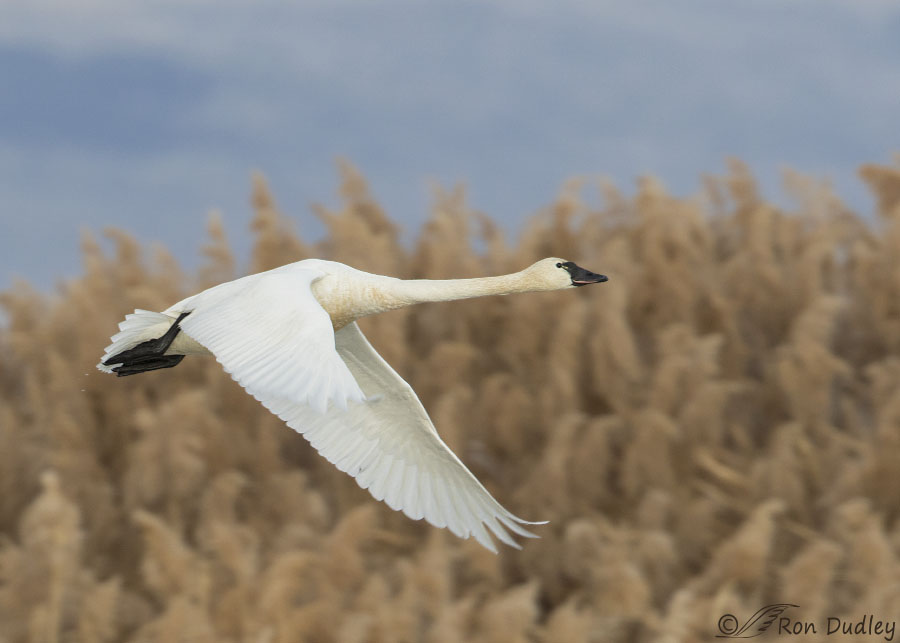
1/800, f/9, ISO 800, Canon 7D Mark II, Canon EF 500mm f/4L IS II USM + EF 1.4 III Extender, not baited, set up or called in
When swans lifted off I was occasionally able to get stands of phragmites in the background which I think adds interest. Usually they took off in small groups so it was difficult to isolate a single swan. This was one of the times I succeeded.
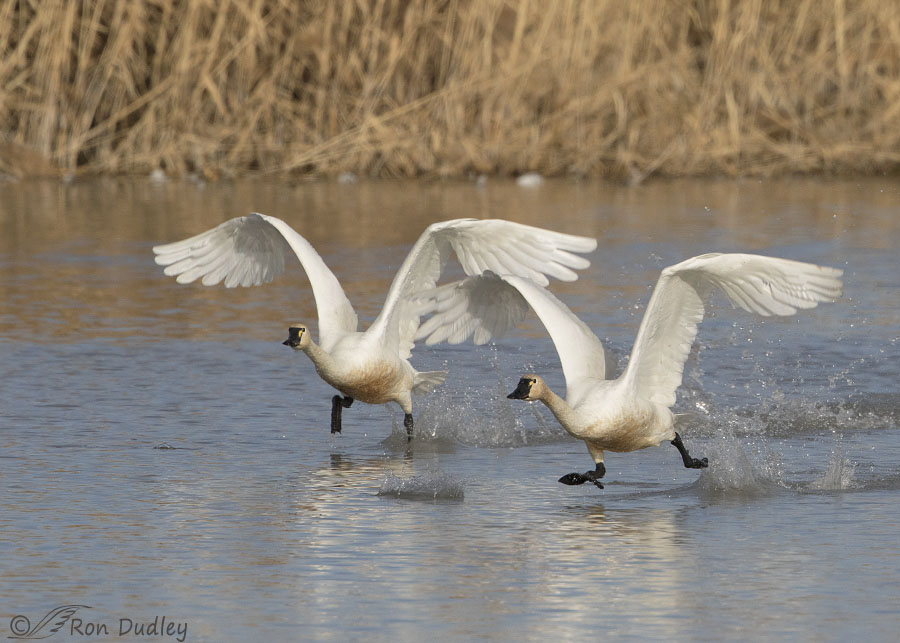
1/2500, f/9, ISO 500, Canon 7D Mark II, Canon EF 500mm f/4L IS II USM + EF 1.4 III Extender, not baited, set up or called in
They would often signal when they were about to take off by bobbing their heads and becoming noisier. This was one of the few times I was able to get clean, sharp shots of two or more birds taking off without having other swans in the photo. I love the running poses.
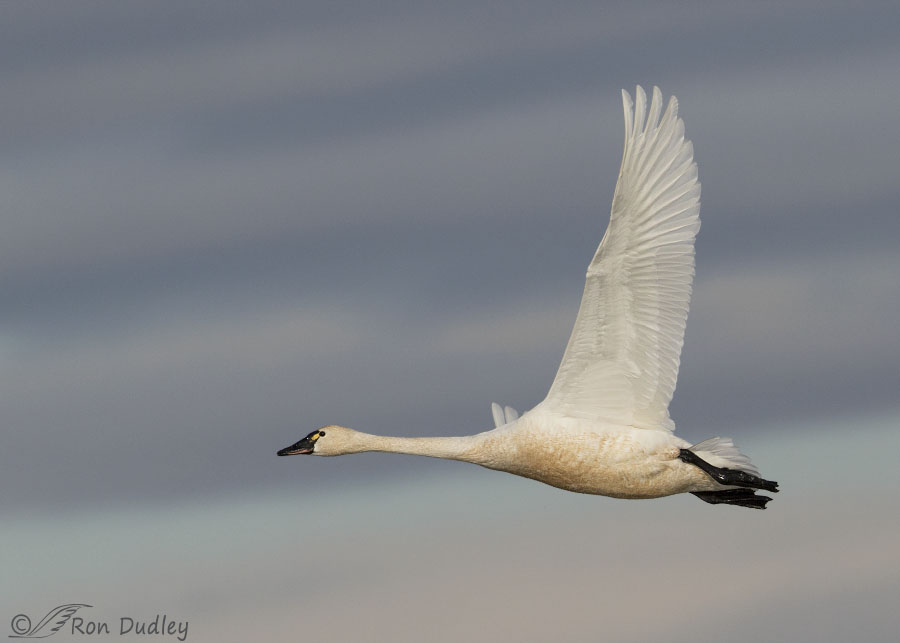
1/3200, f/8, ISO 500, Canon 7D Mark II, Canon EF 500mm f/4L IS II USM + EF 1.4 III Extender, not baited, set up or called in
Here I like the vertically stretched-out wing and the layered clouds in the background.
1/640, f/9, ISO 800, Canon 7D Mark II, Canon EF 100-400mm f/4.5-5.6L IS II USM @ 263 mm, not baited, set up or called in
Occasionally I switched to my smaller zoom lens to try to get multiple birds sharp and provide a better sense of the setting. If you listen to this entire sound clip you’ll hear what I heard up close in this situation – first their noisy calls and then the sounds of a group of them taking off. Those huge wings and splashing feet make a lot of noise too.
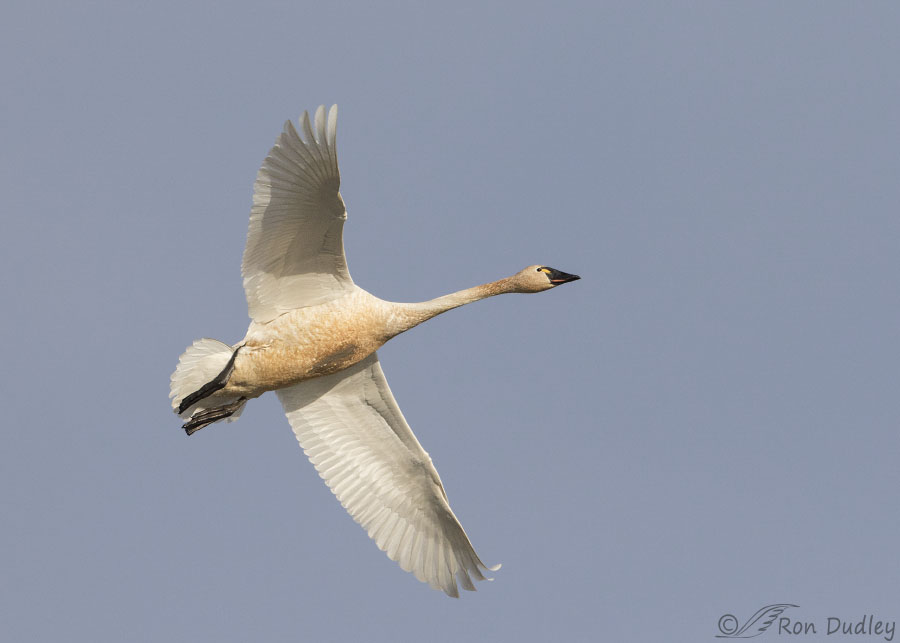
1/4000, f/7.1, ISO 800, Canon 7D Mark II, Canon EF 500mm f/4L IS II USM + EF 1.4 III Extender, not baited, set up or called in
Despite the homogenous background this is a shot I was very happy to get. It may look like I’m shooting nearly straight up at the swan but in reality it was banking at almost 45 degrees and I was shooting almost horizontally. If you look closely you’ll see that its neck is twisted to keep its head level at that severe flight angle. I don’t often see a 15 lb. bird banking this steeply.
- Note: Tundra Swan plumage is all white but it tends to become stained by iron in the water over time, which is what we see here.
I took about 1800 photos yesterday morning and most of them were of swans so I have gobs of image previewing and culling ahead of me. My intention for today’s post is just to provide a sampling of some of the types of swan photos I was able to get. I imagine I’ll be posting more of them in the weeks to come.
Ron
PS – Given my fairly recent post about the history of observation towers at Bear River MBR I thought local readers might be interested in the progress they’ve made on the new tower at the refuge.
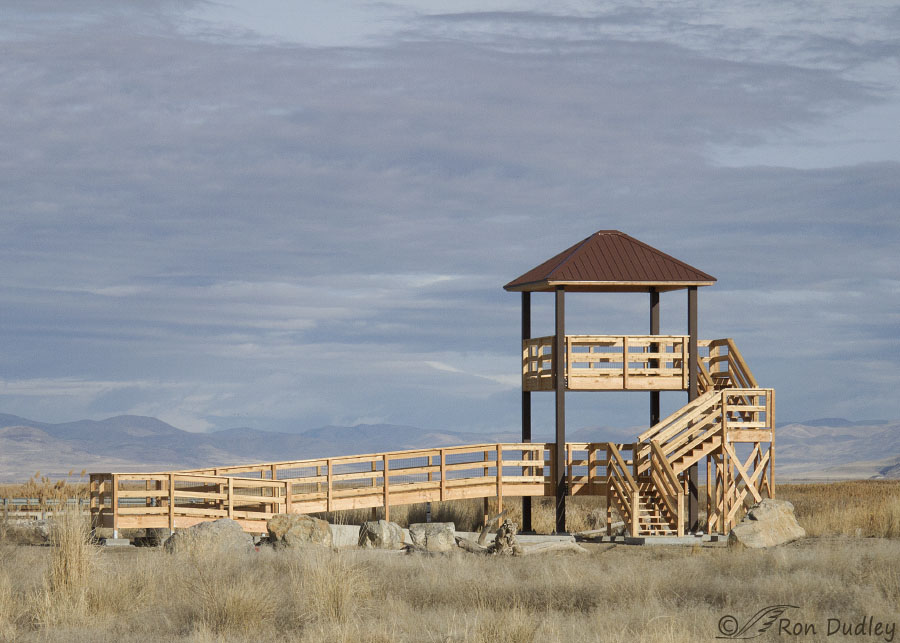
1/1000, f/10, ISO 800, Canon 7D Mark II, Canon EF 500mm f/4L IS II USM + EF 1.4 III Extender, not baited, set up or called in
As of yesterday morning construction appears to be complete (although they may still intend to stain or paint it). I think it’s a welcome addition to the refuge. Interestingly, they’ve now torn down the old ramp and viewing platform at the southwest corner of the auto-tour loop road. That thing was looking pretty rickety…


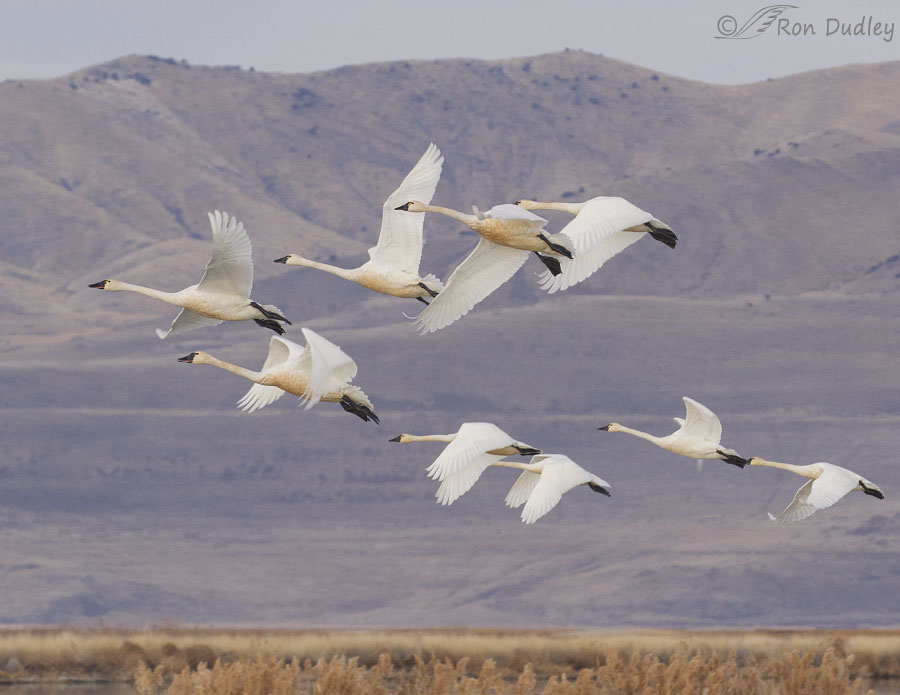
I liked seeing the big view at first of all the birds including the eagle and the subsequent ones as well. The sound was a real treat too and I couldn’t help but think it feels a long way off yet but worth waiting for. I was not aware that they run a bit on take-off, that looks very interesting. All in all, these images just gave me a good feeling. Thanks for sharing.
An awesome series Ron!
Charlotte
thanks for the taste of things to come. I love the tundra swans. There is a landing stop in Aylmer, Ontario (about 2 hours from me) where they come on the way back to the Tundra in march. One year we saw over 4 thousand of them ( plus other sundry geese and ducks ) It was quite magical to witness. There is an quite a large observation tower there and they do a daily count. They feed the birds and the whole thing lasts about 3 weeks from the first swan to the last. We go there at least once every year.
http://paulroeddingphotography.com/tag/aylmer-wildlife-management-area/
The one of the group flying really moved me deeply. Not sure why, but it did. Amazing.
Good. Thanks, Arwen.
Glad to see the observation tower up and running again….hope it (and frefuge) last for many, many years….Swans gather on our reservoirs 30, 40, 100 or so of them every fall…for a feeding, resting stop-over on their migration every fall….love to see them….have been told they not only eat water plants but also eat the nutrient-rich mud…
I’m happy to see the new tower construction, Patty. It’s seemed like something’s been missing ever since they had to remove the old one when it was destroyed by flooding and ice.
Great photos Ron. The first pic is interesting. All types of birds, including a Bald Eagle. Yet the birds looked contented.
Those other birds aren’t as close to the eagle as they look, Jean. My long lens has compressed everything.
Thanks for the lovely photographs of the swans, eagle and tower! From my limited research, this tundra swan is also called a whistling swan. The little yellow patch on the inside edge of the beak and the yellow trim around the outside edge are clearly visible, as well as the iron stains. I hope you will be able to go to the San Luis Valley in Colorado some springtime for the crane arrival. Monte Vista has a Crane Festival on one weekend, but the cranes are in the area for several weeks. I used to visit the Valley with my children during spring break, when there were three whooping cranes still traveling with the flock. Observing 25,000-30,000 sandhill cranes is such fun.
Miriam, Yes, they used to be called Whistling Swans and some folks still use that name.
Beautiful photos. I just got back from BRMBR and am downloading my photos. The swans were magnificent the light horrid. I hope I have a few nice shots. If not I enjoy going for just the sound. It is one of my favorite all time bird sounds. By the way The bald eagle was still in almost the same spot too.
Good luck with your photos, April. At least I had fairly good light for part of the time I was there.
I found a bird with a neck tag. i am just in the process of reporting it.
I looked for tags or bands but didn’t notice any.
Ron, what a wonderful series of photos. You were so fortunate to come upon the Swans and get the right amount of light to shoot.
It sure has been dreary around here and lack of snow makes it worse, so I was excited when I opened your blog and found these wonderful treasures.
Thank you, Ron.
Alice, The light wasn’t particularly good much of the time I was with them but it didn’t matter quite so much with white birds.
Love the calls, the eagle shot, the group flight and the running on water! I’m happy for you that you had this wonderful experience, and it’s a treat to see the outcome.
Thank you, Alison.
Hi Ron Wish I had a good camera.
Wish I had a good camera.
I’m new to your blog. I look forward everyday to see what beautiful birds you have to share. I’ve always loved birds but have never been good at identifying them. So I’m excited to take a bird class next weekend !!
Yesterday I saw some beautiful mergansers 20 females and 2 males swimming in a tight group. Those 2 males had quite the party happening
Welcome to Feathered Photography, Diana. Perhaps a new camera should be next on your list…
That’s what I’m thinking
Love the context shot. And the running shot. And the group flight shot. And the “dad puns.”
The tower sure went up quickly. Hope you get a chance to check it out personally soon.
Marty, I almost went up the tower yesterday. Should have…
WOW, WOW, WOW What a great set of shots, Eagle, ducks and Tundra Swans!!! Yup, you sure got the Tundra Swans. All I can do is look, appreciate and think about all the shots I’ve missed. Man, o Man what a great series! Many thanks for sharing. BTW how long do the swans stay in your area?
Observation tower looks neat, that should be a well used facility.
Thank you, Dick. I don’t remember exactly when they leave but they won’t be here too much longer.
Oh YES! WOW! What a splendid series of images! I think my favorite (by just a skosh) is the one of them running on water. And the sounds! Oh how I remember those sounds in various places I’ve lived (but not here). Isn’t it just outrageously cool? My second favorite is the long view with the bald eagle, but again, just by the slightest tad! They’re all cool!!
I’m just delighted you had a good day
You obviously know what it’s like, Laura. I won’t soon forget it.
For me, it was all the ducks in the world landing (and calling) in the spring-fed creek adjacent to the Tongue River in Wyoming after Mariah (FRT) caught her first wild duck. I will never, EVER forget those sounds, the sights and colors of the setting sun and the sheer joy of those moments! That was probably the best day of my life thus far. Just oh WOW! The splendor of The Great Out There is beyond words! Our language just doesn’t go there!
Just lovely! Thank you for taking and sharing these amazing photos. How I wish I had been there to watch and listen to the Tundra Swans. I am sure it was breathtaking.
It was, Melanie. It certainly was! Thank you.
Jut thrilling ! After the first time through the images, I played the calls recording , then went back thru the images with those calls echoing in my head —thanks so much for the
combination experience from afar– it raised the hairs on my neck and made my eyes “brim”………I’m so happy for you to have had such a gorgeous and productive day !
Kris, I was hearing those calls in my head the entire time I was working on this post. It’s an enchanting sound, especially when you’re on the refuge and you can hear them calling in almost every direction.
Kris, I followed your advice and went back to peruse with the sound of the swans in the background. Fantastic experience! Thank you!
Much welcome pictures of the Tundra Swans, amazing shots. Our local photographer Alistair Fraser, was stating that there used to be Tundra Swans come into this area to rest & feed but he has not seen any in a few years now but we do get Trumpeter Swans in small groups of usually 7 or 8 on occasion, I enjoyed seeing the first picture with the different species of water birds & the lone Bald Eagle. Nice viewing tower as well…a job well done! Ron, does Mia have a Blog as well, would love to see some of her shots too, Thank you again for doing what you do for us.
We get the occasional Trumpeter too, Shirley. They’re significantly larger than Tundras. Yes, Mia’s blog is OnTheWingPhotography.
Wow! Love all of these pictures but especially the photo of the swans all together. You captured the magnificence of the landscape as well as the beauty of the swans.
Thanks, Joanne. I probably should have used that shorter lens more often but in all the excitement…, well, you know how it goes.
Ron, Great series of photos! I especially like the running poses. I share in your excitement as yesterday in central Illinois I visited a wildlife refuge that is only open to public traffic twice a year. Yesterday they were celebrating “Bald Eagle Days” and the public is invited to drive their 8-mile loop on the levee to view birds. We have done this many times, but yesterday was the “bonanza” of bald eagles. We counted nearly 150 on the ice and others reported more at different times of the day. Our experience was great as I’m sure yours was also. Those moments are truly gifts to be treasured forever.
Yes, we remember experiences like this, don’t we, Cindy!
WOW! How “magical”!
How “magical”!  Grinning ear to ear over these photo’s Ron!
Grinning ear to ear over these photo’s Ron!  Being able to get close enough to pull these shots is amazing! Generally the 1st photo is as close as I get to such things…. The Phragmites as a background offer nice texture and contrast. The “running on water” is also fun.
Being able to get close enough to pull these shots is amazing! Generally the 1st photo is as close as I get to such things…. The Phragmites as a background offer nice texture and contrast. The “running on water” is also fun.  Large group came out wonderful also. The new tower certainly won’t offer the view the old one did – imagine it would be cost prohibitive plus all the safety issues now…….. Will offer a good view tho.
Large group came out wonderful also. The new tower certainly won’t offer the view the old one did – imagine it would be cost prohibitive plus all the safety issues now…….. Will offer a good view tho.
Judy, This was the best (and closest) encounter I’ve ever had with Tundra Swans. I was ecstatic!
The refuge representative I talked to a couple of weeks ago told me that this was as tall as the current USFWS safety regulations allow observation towers to be built.